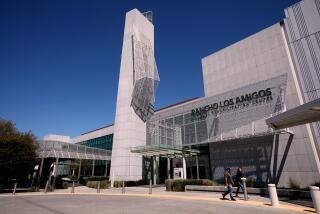Patients are their practice
Savinh Pouv wears a white coat, treats patients and is considered a primary care provider at the Los Angeles County clinic where she works -- but she is not a doctor.
That does not matter to Maria Avalos. What matters, the 55-year-old homemaker said, is that when she comes to the Long Beach clinic to get treated for her diabetes, she always sees Pouv, a nurse practitioner.
“Before, they sent me from one to another” doctor, Avalos said during a visit last week. “I like her --she checks me well, she has my records, she checks my medications and changes them if I need.”
California is among 23 states that allow nurse practitioners to act as primary care providers without a doctor’s supervision, a move aimed at stemming a shortage of physicians and reducing costs.
Now the nurses are poised to take on an even greater role as Los Angeles County and other health systems develop “medical home” models of care that expand the number of primary care providers, including nurses, to meet the requirements of national healthcare legislation, reduce unnecessary hospital visits and cut costs.
Proponents say allowing such nurses to work as primary care providers can ensure that patients get quick, cheap access to care. But some doctors worry that the nurses overreach, doing more than they are trained to do.
Los Angeles is one of six regions in California that have a shortage of primary care physicians, according to a California HealthCare Foundation report last year, part of a national shortage expected to reach 45,000 doctors by the end of the decade, according to the American Assn. of Medical Colleges.
Nurse practitioners are registered nurses with advanced degrees who do many of the things doctors do -- and they cost less to train and hire than doctors, and are easier to find. As of last month, there were about 16,000 nurse practitioners statewide, a 16% increase from five years ago, according to figures from the state nursing board .
At Los Angeles County hospitals and clinics, nurse practitioners are paid $88,000 to $128,000; primary care doctors earn $106,000 to $186,000.
Long Beach Comprehensive Health Center is one of six county clinics that have assigned patients to nurse practitioners. Dr. Mitch Katz, the county’s new health chief, helped start a similar program in San Francisco that he said increased preventive care, decreased patient waits and lowered healthcare costs.
Under the “medical home” model, Pouv is assigned about 1,000 primary care patients. She works with a licensed vocational nurse, registered nurse, mental health worker and a family physician. Dr. Samuel Oregel is assigned his own group of about 1,300 patients but can also help Pouv with complex cases.
“The most important thing for patients is having someone they can identify as their primary care provider,” Oregel said.
If patients didn’t know who their primary care provider was, they often cycled through county emergency rooms and hospitals, where they racked up large medical bills on the county tab. Now, Pouv said, those patients are able to see her quickly. When they do resort to the emergency room, she can track them afterward in a new patient registry and follow up to prevent unnecessary hospitalizations.
“It gives them peace of mind, that they do have access to their provider,” Pouv said.
An Institute of Medicine report last fall urged state officials to expand what nurse practitioners can treat. The report found health systems that increased nurses’ responsibilities delivered “safe, high-quality primary care,” including Kaiser Permanente, the Veterans Health Administration and Geisinger Health System in Danville, Pa.
But Dr. James Hay, president-elect of the California Medical Assn. said some health systems have found such nurses more expensive than doctors because they lack doctors’ training and as a result, refer more patients to specialists and order unnecessary tests.
“We think there’s a vast difference in the depth and breadth of training between nurse practitioners and physicians,” said Hay, a family physician based in San Diego. “We don’t think they’re interchangeable.”
Dr. Rebecca Patchin, who is based at Loma Linda University Medical Center, said health systems need to find other ways to stem the shortage of primary care doctors.
“Increasing the responsibilities of the nurse is not the answer,” said Patchin, who trained as a registered nurse before becoming an anesthesiologist and a member of the board of the American Medical Assn., which opposed the Institute of Medicine report’s recommendation to expand the scope of nurses’ work.
“The majority of patients prefer to have a physician involved in their care, and we think that’s best,” Patchin said.
Many academics disagree. “There isn’t a lot of evidence out there that primary care doctors during a regular office visit deliver a better quality of care or do a better job than a nurse practitioner,” said Dylan Roby, a research scientist at the UCLA Center for Health Policy Research.
At the Long Beach clinic, Pouv said that having Dr. Oregel on her team reassures patients.
“They know that I’m not making a decision on my own if there’s something I’m not sure of,” she said.
Los Angeles County health officials plan to expand the medical home program in July to include the rest of the county’s 21 primary care clinics, staffed by 70 primary care physicians and about 22 nurse practitioners and physician assistants. If that succeeds, they aim to expand the program to scores of county-supported private primary healthcare clinics.
--
molly.hennessy-fiske@latimes.com
More to Read
Sign up for Essential California
The most important California stories and recommendations in your inbox every morning.
You may occasionally receive promotional content from the Los Angeles Times.











